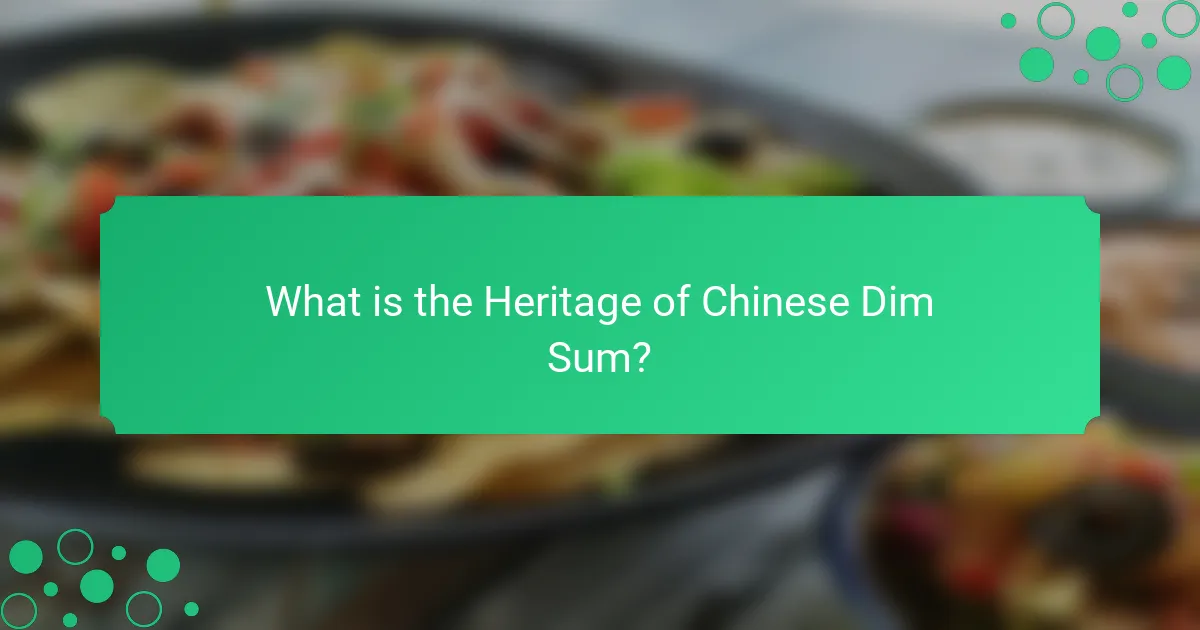Chinese Dim Sum is a traditional culinary practice with roots in Cantonese culture, originating from the Guangdong province. It consists of a variety of small dishes, including dumplings, buns, rolls, and tarts, typically served with tea in a social dining setting. Traditional preparation methods include steaming, frying, and baking, each enhancing the flavors and textures of the dishes. Dim Sum is commonly enjoyed during family gatherings and special occasions, fostering community and hospitality. The practice also reflects cultural values, with specific dishes served during festivals to honor ancestors, highlighting the significance of togetherness in Chinese society.

What is the Heritage of Chinese Dim Sum?
Chinese Dim Sum has a rich heritage rooted in Cantonese culture. It originated from the Southern provinces of China, particularly Guangdong. Historically, it began as a light meal for travelers along the Silk Road. Over time, it evolved into a social dining experience. Dim Sum includes a variety of small dishes served with tea. Traditional tea houses popularized this practice in the 19th century. Today, Dim Sum is enjoyed worldwide, symbolizing Chinese culinary artistry. Its heritage reflects a blend of tradition, community, and culinary skill.
How did Dim Sum originate in Chinese culture?
Dim Sum originated in Chinese culture as a traditional Cantonese meal served with tea. It began during the Tang Dynasty (618-907 AD) when travelers stopped at tea houses along the Silk Road. These tea houses offered light snacks to complement tea drinking. Over time, the practice evolved into a dining experience featuring a variety of small dishes. By the Song Dynasty (960-1279 AD), Dim Sum became popular in Southern China. It was commonly enjoyed during social gatherings and celebrations. Today, Dim Sum is recognized globally and remains an integral part of Chinese culinary heritage.
What historical events influenced the development of Dim Sum?
Dim Sum’s development was influenced by several historical events. The Song Dynasty (960-1279) saw the rise of tea houses, where small dishes were served to accompany tea. This practice evolved into what we now know as Dim Sum. During the Qing Dynasty (1644-1912), the popularity of Dim Sum grew in Guangdong province. The influx of foreign trade during this period introduced new ingredients and cooking techniques. Additionally, the establishment of Cantonese cuisine as a dominant culinary style further shaped Dim Sum’s offerings. The cultural exchange during the Opium Wars also played a role in diversifying Dim Sum. These events collectively contributed to the rich variety and tradition of Dim Sum enjoyed today.
How has the perception of Dim Sum evolved over time?
Dim Sum’s perception has evolved from a traditional Cantonese meal to a global culinary phenomenon. Initially, it served as a light snack for travelers on the Silk Road. Over time, it became a communal dining experience in tea houses in Southern China. In the 20th century, Dim Sum gained popularity in Western countries as Chinese immigrants opened restaurants. Today, it is celebrated for its variety and artistry, appealing to diverse palates. Modern interpretations include fusion dishes and gourmet offerings. This evolution reflects broader trends in globalization and culinary exploration. The rise of food culture on social media has further enhanced its visibility and appreciation.
What are the key characteristics of Dim Sum?
Dim Sum is a traditional Cantonese cuisine consisting of small, bite-sized portions served in steamer baskets or on small plates. Key characteristics include a variety of dishes, such as dumplings, buns, and pastries. Dim Sum is often enjoyed during brunch or tea time, promoting social interaction. The dishes can be savory or sweet, providing a wide range of flavors. Dim Sum is typically served with tea, enhancing the dining experience. The preparation methods include steaming, frying, and baking, showcasing diverse culinary techniques. Traditionally, Dim Sum is served in a communal style, encouraging sharing among diners. This dining practice dates back to the Song Dynasty, highlighting its historical significance in Chinese culture.
What types of ingredients are commonly used in Dim Sum?
Dim Sum commonly uses a variety of ingredients. These ingredients include meats, seafood, vegetables, and starches. Pork is a popular meat choice, often found in dumplings. Shrimp is frequently used in both dumplings and rolls. Chicken is another common ingredient, often prepared in various forms. Vegetables like bok choy and mushrooms add flavor and texture. Rice flour is used for dumpling wrappers, while wheat flour is common for buns. Additionally, seasonings such as soy sauce and sesame oil enhance the dishes. These ingredients reflect the diversity and richness of Dim Sum cuisine.
How does the presentation of Dim Sum reflect cultural values?
The presentation of Dim Sum reflects cultural values through its emphasis on communal dining and artistry. Dim Sum is traditionally served in small portions, encouraging sharing among diners. This practice highlights the importance of family and friendship in Chinese culture. The intricate presentation of Dim Sum showcases culinary skill and attention to detail. Each dish often features vibrant colors and delicate designs, representing harmony and balance. Additionally, the use of bamboo steamers symbolizes respect for nature and sustainability. Overall, the presentation of Dim Sum embodies the cultural values of togetherness, artistry, and respect for the environment.

What are the different types of Dim Sum?
Dim Sum includes various types of small dishes served in Chinese cuisine. Common types are dumplings, buns, and rolls. Dumplings can be filled with shrimp, pork, or vegetables. Buns may be steamed or baked, often with meat fillings. Rolls include rice paper or spring rolls, typically filled with vegetables or seafood. Other types are tarts, such as egg tarts, and congee, a rice porridge. Each type is often served with dipping sauces. Dim Sum is traditionally served in small portions, allowing for a variety of tastes.
What are the main categories of Dim Sum dishes?
The main categories of Dim Sum dishes include dumplings, buns, rolls, and pastries. Dumplings are often filled with meat or vegetables and come in various styles, such as steamed or fried. Buns, like char siu bao, are soft and fluffy, typically filled with barbecued pork. Rolls, including spring rolls and rice rolls, offer crispy or chewy textures filled with different ingredients. Pastries, such as egg tarts and sesame balls, provide a sweet or savory finish. These categories encompass a wide range of flavors and textures, reflecting the diverse culinary traditions of Chinese cuisine.
How do steamed Dim Sum differ from fried varieties?
Steamed Dim Sum differ from fried varieties primarily in cooking method and texture. Steamed Dim Sum are cooked using steam, resulting in a soft and moist texture. The steaming process preserves the natural flavors of the ingredients. In contrast, fried Dim Sum are cooked in oil, creating a crispy and crunchy exterior. This frying method often adds a richer flavor profile. Nutritionally, steamed Dim Sum tend to be lower in calories and fat compared to their fried counterparts. The choice between steamed and fried varieties can also affect the overall dining experience and presentation.
What are some popular fillings found in Dim Sum?
Popular fillings found in Dim Sum include shrimp, pork, chicken, and vegetables. Shrimp dumplings, known as har gow, are filled with fresh shrimp and bamboo shoots. Pork buns, or cha siu bao, contain barbecued pork in a soft bun. Chicken feet, or feng zhua, are marinated and steamed for flavor. Vegetable dumplings often include mushrooms, carrots, and cabbage. These fillings highlight the variety and richness of Dim Sum cuisine. Each filling contributes to the overall experience of savoring Dim Sum.
What role do Dim Sum carts play in dining experiences?
Dim Sum carts enhance dining experiences by offering a unique and interactive way to enjoy food. They allow diners to choose from a variety of small dishes presented visually. This method promotes social interaction among guests as they share and sample different items. The carts are often pushed around the dining area, creating a sense of spontaneity and excitement. Additionally, they reflect the cultural tradition of communal dining in Chinese cuisine. This practice dates back centuries and emphasizes the importance of sharing meals. The visual appeal of the carts and the variety of options available contribute to a festive atmosphere. Overall, Dim Sum carts play a significant role in elevating the dining experience through interactivity and cultural significance.
How do diners interact with Dim Sum carts during a meal?
Diners interact with Dim Sum carts by selecting dishes directly from them. The carts are wheeled around the dining area, showcasing various small plates. Diners can visually inspect the offerings before making a choice. Each cart typically contains a different type of Dim Sum, such as dumplings or buns. Diners signal to the server to stop the cart when they see something they want. They may also ask questions about the dishes or request specific items. This interactive process allows for a communal dining experience. The practice enhances the enjoyment of the meal by promoting sharing and exploration of flavors.
What is the significance of the cart system in Dim Sum culture?
The cart system is significant in Dim Sum culture as it enhances the dining experience. This system allows servers to bring a variety of dishes directly to tables. Diners can choose items visually, promoting interaction and exploration. The cart system reflects traditional Chinese communal dining practices. It encourages sharing and sampling multiple dishes. Historically, this method originated in Cantonese tea houses. It has become a hallmark of Dim Sum restaurants globally. The cart system contributes to the lively atmosphere typical of Dim Sum meals.

What are the traditional preparation methods for Dim Sum?
Traditional preparation methods for Dim Sum include steaming, frying, and baking. Steaming is the most common method, preserving flavors and moisture. Bamboo steamers are often used, allowing for even cooking. Frying is utilized for dishes like spring rolls, providing a crispy texture. Baking is less common but used for items like baked buns. Each method enhances the unique taste and texture of Dim Sum. These techniques have been passed down through generations, reflecting the culinary heritage of Chinese cuisine.
How is Dim Sum typically prepared in Chinese kitchens?
Dim Sum is typically prepared through steaming, frying, or baking various bite-sized dishes. In Chinese kitchens, chefs often use bamboo steamers to cook dumplings and buns. This method preserves moisture and enhances flavor. Ingredients like shrimp, pork, and vegetables are commonly used. The preparation process involves mixing, shaping, and filling dough or wrappers. After assembling, the items are cooked until they reach the desired texture. Some dishes are served with dipping sauces, adding to the overall taste experience. Dim Sum reflects regional variations and traditional recipes passed down through generations.
What techniques are used in the steaming process of Dim Sum?
The steaming process of Dim Sum primarily uses bamboo steamers. Bamboo steamers allow for even heat distribution and moisture retention. They are often stacked to maximize space and efficiency. Water is heated in a wok or pot below the steamer. The steam rises through the bamboo, cooking the Dim Sum delicately. This method preserves flavors and textures. The steaming time varies based on the type of Dim Sum. Traditional techniques emphasize timing to ensure optimal doneness.
How does frying impact the flavor and texture of Dim Sum?
Frying enhances the flavor and texture of Dim Sum significantly. The high heat during frying creates a crispy exterior. This contrast with the soft interior provides a pleasing mouthfeel. The Maillard reaction occurs, adding complex flavors and aromas. Frying also intensifies the natural flavors of the ingredients used. For example, filled dumplings develop a rich, savory taste. The oil used can impart additional flavors, such as sesame or peanut. Overall, frying transforms Dim Sum into a more flavorful and texturally diverse dish.
What tools and equipment are essential for making Dim Sum?
Essential tools and equipment for making Dim Sum include a bamboo steamer, rolling pin, and mixing bowls. A bamboo steamer is crucial for steaming dumplings and buns evenly. The rolling pin is used to flatten dough for wrappers. Mixing bowls are necessary for combining ingredients for fillings. A knife is important for chopping vegetables and proteins. A pastry brush helps in applying oils or sauces. Measuring cups and spoons ensure accurate ingredient portions. Finally, a wok can be used for stir-frying or preparing certain Dim Sum dishes. These tools facilitate the traditional preparation process of Dim Sum, ensuring authenticity and quality.
What types of steamers are commonly used in Dim Sum preparation?
Bamboo steamers and metal steamers are commonly used in Dim Sum preparation. Bamboo steamers are traditional and allow steam to circulate effectively. They are lightweight and impart a subtle flavor to the food. Metal steamers, such as stainless steel or aluminum, are durable and heat evenly. These steamers often come with multiple tiers for cooking several dishes simultaneously. Both types are essential for achieving the desired texture and flavor in Dim Sum dishes.
How do specialized utensils enhance the Dim Sum-making process?
Specialized utensils enhance the Dim Sum-making process by providing tools tailored for specific tasks. For example, bamboo steamers allow for even cooking and moisture retention. These steamers are designed to fit neatly over pots, maximizing space and efficiency. Additionally, a rolling pin designed for dough helps achieve the perfect thickness for wrappers. The precision of these utensils ensures consistency in size and shape. Moreover, specialized molds can create intricate designs, elevating the visual appeal of Dim Sum. Using the right tools reduces preparation time and improves overall quality. Studies show that traditional tools can lead to better texture and flavor in the final product.

What cultural traditions surround the consumption of Dim Sum?
Dim Sum is traditionally consumed during social gatherings and family meals in Chinese culture. This practice emphasizes sharing small portions of various dishes among diners. It often takes place during weekends or special occasions, fostering a sense of community. The act of enjoying Dim Sum is commonly paired with tea, creating a tea-drinking ritual known as “yum cha.” In many regions, particularly Guangdong, Dim Sum is a cultural staple that symbolizes hospitality and warmth. Additionally, certain dishes may be served during festivals to honor ancestors. Overall, the consumption of Dim Sum reflects deep-rooted values of togetherness and celebration in Chinese society.
Why is Dim Sum often associated with social gatherings?
Dim Sum is often associated with social gatherings because it is traditionally served in a communal style. This encourages sharing and interaction among diners. The variety of small dishes allows for a diverse dining experience. People can sample multiple flavors and textures together. Historically, Dim Sum originated as a snack for travelers along the Silk Road. Over time, it evolved into a social dining experience in tea houses. The practice of enjoying Dim Sum with family and friends fosters bonding. This cultural aspect emphasizes connection and conversation during meals.
What customs are practiced during Dim Sum meals?
Dim Sum meals are accompanied by several customs. One common practice is the use of tea. Diners typically enjoy various types of tea throughout the meal. Another custom is sharing dishes among the table. This promotes a communal dining experience. Additionally, diners often use small plates to serve themselves. This allows for sampling multiple dishes. Tipping is also customary in some regions. It reflects appreciation for the service provided. Lastly, the timing of Dim Sum is significant. It is traditionally enjoyed during brunch hours, typically from late morning to early afternoon.
How does Dim Sum reflect family values in Chinese culture?
Dim Sum reflects family values in Chinese culture by emphasizing communal dining and shared experiences. This culinary tradition encourages families to gather around a table, fostering connection and togetherness. The act of sharing small plates promotes interaction and communication among family members. Historically, Dim Sum originated as a way for families to enjoy leisurely meals together during tea time. The variety of dishes available allows for diverse tastes, catering to all family members. This inclusivity reinforces the importance of family unity and harmony in Chinese culture. Moreover, the preparation of Dim Sum often involves family participation, strengthening bonds through cooking together.
What are some modern adaptations of Dim Sum traditions?
Modern adaptations of Dim Sum traditions include fusion flavors and innovative presentations. Restaurants now offer unique fillings like truffle or lobster in dumplings. Some establishments serve Dim Sum in a tapas-style format, allowing for shared plates. Vegan and gluten-free options have emerged to cater to diverse dietary preferences. Technology has influenced the ordering process, with apps enabling customers to customize their selections. Additionally, modern venues often incorporate a chic, contemporary ambiance, attracting younger diners. These adaptations reflect changing tastes while preserving the essence of traditional Dim Sum.
How have international influences shaped contemporary Dim Sum offerings?
International influences have significantly shaped contemporary Dim Sum offerings. Global culinary trends have introduced new ingredients and flavors. For example, fusion Dim Sum incorporates elements from various cuisines, such as truffle oil and avocado. Additionally, international dining experiences have popularized Dim Sum outside of China. This exposure has led to the creation of unique variations, such as dessert Dim Sum featuring Western sweets. Furthermore, the rise of health-conscious eating has prompted the inclusion of lighter, gluten-free options. The adaptation of cooking techniques has also occurred, with steaming and frying methods evolving to meet diverse palates. Overall, these influences have expanded the traditional boundaries of Dim Sum, making it more accessible and appealing to a global audience.
What are popular fusion Dim Sum dishes today?
Popular fusion Dim Sum dishes today include truffle dumplings, Korean BBQ bao, and lobster wontons. Truffle dumplings combine traditional flavors with gourmet ingredients. Korean BBQ bao features Korean-style marinated meats in a classic bao bun. Lobster wontons incorporate seafood for a luxurious twist on the original recipe. These dishes reflect a blend of culinary traditions. They showcase creativity in modern dining experiences. The popularity of fusion Dim Sum is evident in many contemporary restaurants. Chefs experiment with diverse flavors to attract a wider audience.
What tips can enhance your Dim Sum dining experience?
To enhance your Dim Sum dining experience, arrive early to avoid long waits. Many restaurants serve fresh items in the morning. Try a variety of dishes to fully appreciate the cuisine. Dim Sum includes dumplings, buns, and rolls. Use chopsticks or small plates for easier handling. Pair your meal with tea for an authentic touch. Take your time and savor each bite. This practice allows you to enjoy the flavors and textures. Engaging with the staff can also provide insights into the menu.
How can you choose the best Dim Sum dishes at a restaurant?
To choose the best Dim Sum dishes at a restaurant, focus on freshness and variety. Look for dishes that are made to order, as they are usually fresher. Observe the menu for popular items like shrimp dumplings and pork buns. Ask the staff for recommendations based on local favorites. Pay attention to the presentation of the dishes; appealing visuals often indicate quality. Consider the ingredients used; premium ingredients enhance flavor. Check online reviews or ratings for the restaurant’s Dim Sum offerings. Look for restaurants that specialize in Dim Sum, as they are more likely to provide authentic options.
What etiquette should you follow when enjoying Dim Sum with others?
When enjoying Dim Sum with others, share dishes and allow everyone to taste. This promotes a communal dining experience. Use chopsticks or serving utensils to take food from shared plates. Avoid using personal chopsticks for this purpose. Wait for the host or elder to start eating before you begin. This shows respect for traditions. Be mindful of table manners, such as not speaking with food in your mouth. Additionally, it is courteous to express appreciation for the meal. This aligns with the cultural significance of Dim Sum as a social event.
The primary entity of this article is Chinese Dim Sum, a traditional Cantonese cuisine with a rich heritage. The article explores its historical origins, tracing back to the Tang Dynasty and its evolution into a global culinary phenomenon. Key topics include the various types of Dim Sum, traditional preparation methods, and cultural traditions surrounding its consumption. Additionally, it examines the significance of communal dining, the role of Dim Sum carts, and modern adaptations influenced by international cuisine. The comprehensive overview provides insights into the diverse attributes and values associated with Dim Sum in Chinese culture.




